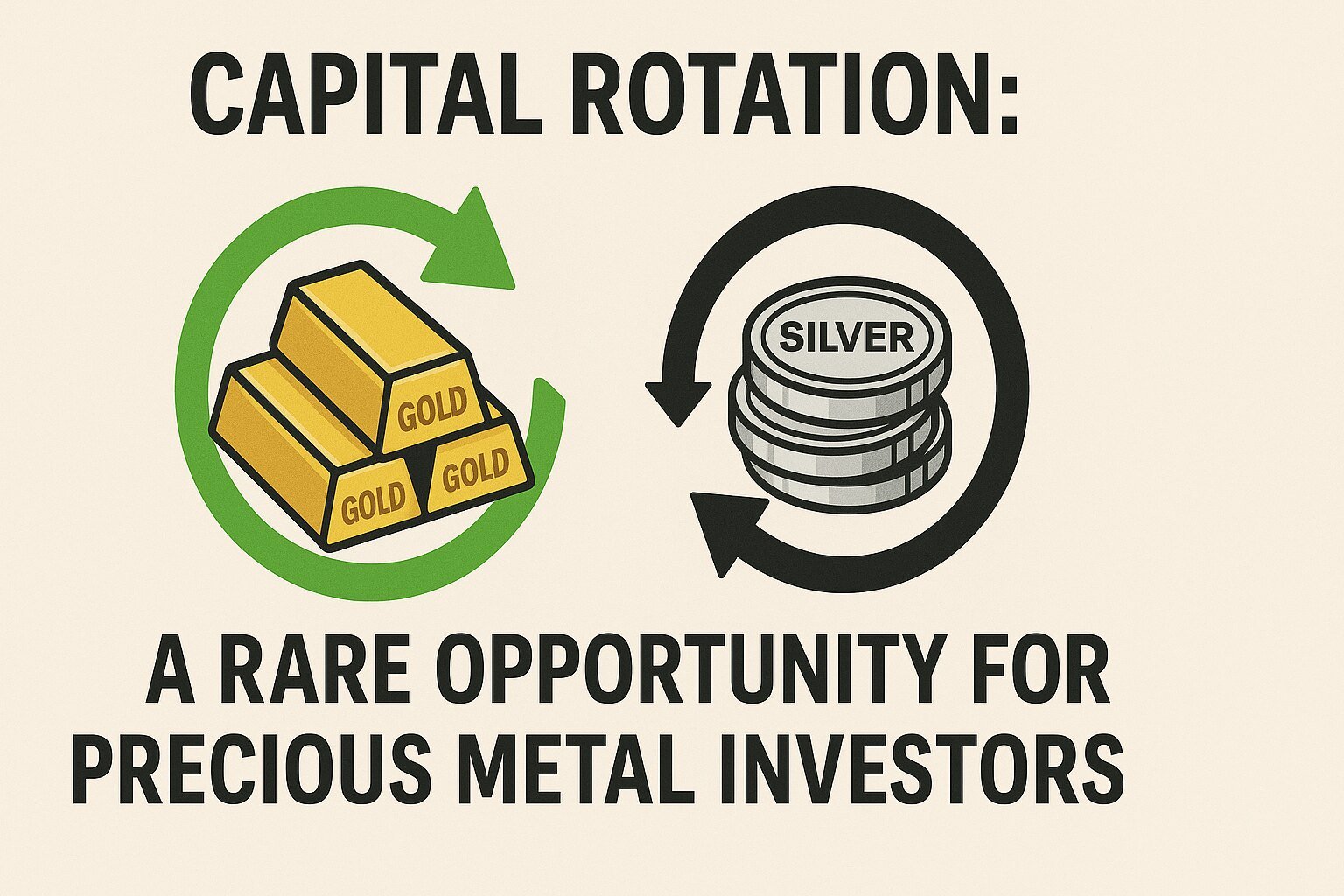In the investment world, change is the only constant. The markets are rising and falling, atmosphere changes, and sometimes in a big way moves money. Much of that.
One of the largest clues that is changing? Something called a Capital rotation event. And if you are interested in protecting (and growing) what you have worked so hard for, especially with gold and silver, understanding of capital rotation can make a real difference.
Let’s break it down.
What is the capital rotation anyway?
Think of capital rotation as a crowded party where everyone suddenly decides to leave the warm, noisy space (stocks) and go to a quieter, safer room (precious metals).
Capital rotation happens when investors overall move their money from one asset class to another – usually because they seek better returns or more security based on what is happening in the economy.
When it comes to precious metalsRotation often means to change out of stocks and bonds and in gold and silver, especially in uncertain times.
Seeing these moments early can be a huge advantage.
Why investors rotate to precious metals
There are a few important reasons why investors move their money into gold and silver:
- Financial uncertainty: When the economy feels shaking – whether it is from inflation, geopolitical tensions or financial system risks – Gold’s reputation shines as a safe harbor. A good example? In 2020, below the top of pandemic uncertainty, gold skipped over 25%.
- Rising inflation: When everyday costs go up and dollars buy less, investors often turn to gold and silver, which historically has their value better than paper currencies.
- Falling confidence in stocks and bonds: If shares for shares feel foamy, business earnings disappointing or interest rates are rising, investors look for alternatives. Precious metals become an attractive way of diversifying.
- Devaluation of currency: When governments flood the system with money (think stimulus programs or massive debt loads), the value of currencies can erode over time. Gold and silver can act as a shield against this hidden treasure.
How rare is a capital rotation event?
Here are things interesting: Real capital rotation events are Extremely rare—And they often mark a walk-in-one-generation investment opportunities.
Alan Hibbard recently discussed this phenomenon with Kevin Wadsworth and Patrick Karim, co -founders of Northstar Bad Charts. Together they emphasized that real capital rotations for precious metals have only occurred a handful of times in the past century.
Here are three large examples:
- 1929: After the stock market crash it took the S&P 500 25 years to make new heights.
- 1972: After the top of the smart fifty bubble took it 8 years For stocks to recover.
- 2000: After the technical bubble burst it took the S&P 500 12 years to reach new heights.
In each case, capital rotated strongly in gold and silver as investors sought a safer soil – and those who placed early were rewarded nicely.
Today, according to Hibbard and Northstar, We see the early signs of another major capital rotation – One that could reshape the investment landscape in the coming years.

During their conversation, they highlight a few key signals that capital is moving towards gold and silver.
1. The Dow-to-Gold Relationship
This simple metric measurement, how many ounces of gold it would take to buy dow jones industrial average.
- When the relationship is high (Over 15) stocks are expensive compared to gold.
- When it is low (Below 5) Looks gold expensive – or stocks are cheap.
During major economic crises such as 2008 and 2020, this relationship fell as investors rushed to gold for security.
2. The relationship between gold and silver
Another useful signal compares the relative value between gold and silver.
Historically Relationship between gold and silver have swung between about around 50: 1 and 70: 1. ONE High relationship – Like 80: 1 or higher – often signals that silver is significantly underestimated compared to gold.
Today we see extreme levelsWith the gold-to-silver ratio that is hovering around 100: 1 – Far over historical average.
This suggests that silver could be ready for big winnings if the story repeats itself. In earlier periods when the relationship reached similar extreme, investors who rotated in silver in front of the trend were rewarded nicely – such as in 2020 when silver almost rose 48%Better than Gold’s 25% ladder.
For a deeper analysis, see Alan’s conversation with Kevin and Patrick from Northstar Badcharts here.
Last Thoughts: Be Ready, Not Reactive
Capital rotation events do not often come around and they certainly do not come with flashing lights or headings on the front.
At that time, mainstream messages, much of the big feature is often already underway.
Recognizing the signs now – and trading with a smart, informed strategy – can enable you not just to weather the storm, but potentially thrive through it.
Whether you are seeking protection, growth or a combination of both, precious metals have historically been a powerful tool to navigate change – and to preserve what matters most.
Ready to learn more? Explore ours Latest insight into how to invest in larger market rotations →
Disclaimer: This information is provided for educational purposes only and should not be considered as investment advice. Previous performance is not a sign of future results. Always do thorough research or consult with a financial advisor before making investment decisions.

